You searched for: pos机如何推广【TG飞机:@bapingseo】谷歌推广ADS【TG电报:@bapingseo】私有博客网络外贸推广【Telegram:@bapingseo】2分快乐8appmg游戏嘉年华?0aKOMe/j4TO2l.html
<< Previous | Displaying results 351-400 of 562 for "pos机如何推广【TG飞机:@bapingseo】谷歌推广ADS【TG电报:@bapingseo】私有博客网络外贸推广【Telegram:@bapingseo】2分快乐8appmg游戏嘉年华?0aKOMe/j4TO2l.html" | Next >>
-
Laura Litwak
ID CardLaura was the second of five children born to religious Jewish parents in the industrial city of Lvov. She was often called affectionately by her nickname, Lorka. Coming from an educated family living in a multi-ethnic part of Poland, she grew up speaking Polish, Russian, German and Yiddish. As a young woman, she earned a humanities degree from St. Nicholas University in Lvov. 1933-39: In April 1935 Laura became Mrs. Daniel Schwarzwald. Her husband was a successful lumber exporter, and they lived in a…

-
War Refugee Board: Background and Establishment
ArticleIn January 1944, FDR established the War Refugee Board which was charged with “immediate rescue and relief of the Jews of Europe and other victims of enemy persecution.”

-
Alexander Schenker describes working as a lumberjack in a labor camp in Siberia
Oral HistoryFollowing the German invasion of Poland in September 1939, Alexander and his family fled eastward to Lvov. His father then fled to Vilna, hoping to obtain visas for the family to escape through Japan. The rest of the family was caught while trying to cross border into Lithuania in order to meet up with Alexander's father. They returned to Lvov. Alexander and his mother were later arrested for refusing to declare Soviet citizenship. They were sent to a labor camp in the Soviet interior. After their release…

-
Immediate American Responses to the Nazi Book Burnings
ArticleThe Nazi book burnings of 1933 sparked responses from anti-Fascist organizations, Jewish groups, and writers in the United States. Learn more.

-
SS and the Camp System
ArticleIn 1933-1934, the SS seized control of the Nazi camp system. Learn more about the persecution, forced labor, and murder that occurred under SS camp rule.

-
Introduction to the Definition of Genocide
ArticleExplore an outline of the main definitional elements of the crime of genocide and how significant aspects of the law have developed through recent cases.

-
Antisemitism
ArticleThroughout history Jews have faced prejudice and discrimination, known as antisemitism. Learn more about the long history of antisemitism.
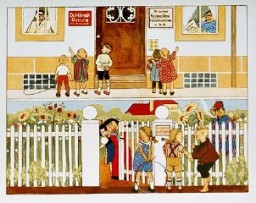
-
Oskar Schindler
ArticleOskar Schindler's actions to protect Jews during the Holocaust saved over 1,000 Jews from deportation. Learn more about Schindler's List.

-
The Farhud
ArticleThe Farhud (pogrom), an outbreak of mob violence against Baghdad Jewry in June 1941, was a turning point in the history of Jews in Iraq. Learn more
-
Trawniki
ArticleFrom July 1941-May 1944, the SS camp at Trawniki had several purposes. It is best known as the training site for auxiliary police guards used in Nazi killing centers. Learn more.

-
Hodonín U Kunštátu (Hodonín bei Kunstadt) (Roma camp)
ArticleIn March 1942, the Hodonin camp was classified as a camp for Roma. It was a transfer station during deportation to Auschwitz-Birkenau. Learn about the camp and its history.

-
The Nazi Party
ArticleThe National Socialist German Worker’s Party, also known as the Nazi Party, was the far-right racist and antisemitic political party led by Adolf Hitler.

-
Chaya Szabasson Rubinstein
ID CardIn 1930 Chaya married Mordecai Rubinstein, a businessman, and moved with him from her hometown of Kozienice to the nearby city of Radom. Chaya had been raised in a religious, Yiddish-speaking Jewish family, and her father owned a lumber mill near the Kozienice birch forest. In Radom, Chaya's husband operated a small bus line. 1933-39: Chaya gave birth to a daughter, Gila, in 1933. In the mid 1930s the Rubinsteins moved back to Kozienice. There, they were trapped when German troops invaded [Poland] in…
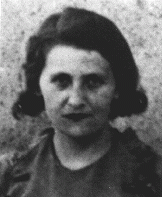
-
Rebecca Pissirilo
ID CardRebecca was the oldest of three children born to Ladino-speaking, Sephardic-Jewish parents. The Pissirilos lived in Kastoria, a small town in the mountainous region of Greek Macedonia near the Albanian border. Rebecca's father was a successful fabric merchant. The Pissirilo children attended public schools. 1933-39: After finishing elementary school, Rebecca went on to study at secondary school. She liked to sing and enjoyed studying. Rebecca kept a diary, like some of the other girls in her class. The…
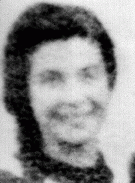
-
Notice of Gregor Wohlfahrt's execution
DocumentAuthorities in Berlin, Germany, sent this notice to Barbara Wohlfahrt, informing her of her husband Gregor's execution on the morning of December 7, 1939. Although he was physically unfit to serve in the armed forces, the Nazis tried Wohlfahrt for his religious opposition to military service. As a Jehovah's Witness, Wohlfahrt believed that military service violated the biblical commandment not to kill. On November 8, 1939, a military court condemned Wohlfahrt to beheading, a sentence carried out one month…

-
Beads used by a Dutch Jewish girl in hiding
ArtifactThese tiny black, white, gold, and clear glass beads were used by Rachel “Chelly” de Groot from November 1942 to April 1944 and recovered by her brother Louis after the war. Chelly used the beads to make handicrafts. On November 16, 1942, Chelly, then 15, Louis, 13, and their parents Meijer and Sophia left Arnhem and went into hiding after the Dutch police warned them of a raid. Meijer and Sophia hid in Amsterdam while Chelly and Louis moved around to different locations. In summer or fall 1943,…
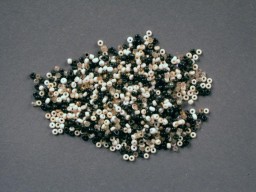
-
David Birnbaum
ID CardDavid, known as Dudek by his family and friends, came from Radom, a city with a large Jewish population. David's family was involved in Zionist activities, and David attended a Jewish religious school every afternoon after returning from public school. His father owned a distillery. 1933-39: The Germans invaded Poland on September 1, 1939, and Radom was occupied on September 8, 1939. The Germans were seizing Jewish men to work as slave laborers, and the Birnbaum family knew that they might spare those who…
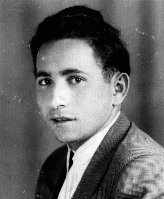
-
Leah Kohl Rapaport
ID CardLeah and her four brothers were raised in a religious Jewish family in the city of Lvov. After obtaining her high school diploma, Leah attended university for one year. In 1931 she married Joseph Rapaport, and the couple settled in Warsaw. 1933-39: The Rapaports lived in the suburbs, and Joseph worked as a banker. Their daughter Zofia was born in May 1933. Each year at the Jewish holiday of Passover, they returned to Lvov to visit Leah's parents. Two days after Joseph was mobilized for military duty in…

-
Max Krakauer
ID CardMax was the oldest of six children born to Jewish parents in the small Moravian town of Hodonin, where his father ran a dry-goods and clothing store. His family spoke both Czech and German at home, and Max attended German-language schools in Hodonin and Lipnik. He completed his education in 1920. Born with a heart condition, Max lived a sheltered life. 1933-39: Max's father, Bernard, was getting on in years and wanted to retire. Max was not strong enough to take over the business, so the Krakauers sold…

-
Lodz
ArticleNazi authorities established the Lodz ghetto in 1940. Learn about living conditions and forced labor in the ghetto, as well as deportations to and from there.

-
Dawid Sierakowiak
ArticleYoung people's diaries capture some of the most heartbreaking experiences of the Holocaust. Learn about the diary and experiences of David Sierakowiak.
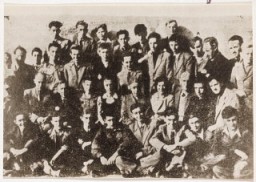
-
Advertisement for the Violetta women's club
DocumentA newspaper advertisement for the Damenklub Violetta, a Berlin club frequented by lesbians, 1928. Before the Nazis came to power in 1933, lesbian communities and networks flourished in Germany.

-
Liberation of Auschwitz: Child survivors
FilmSoviet military footage showing children who were liberated at Auschwitz by the Soviet army in January 1945.
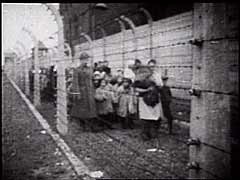
-
Truman proclaims victory in Europe
FilmWorld War II began with the German invasion of Poland in September 1939 and ended in Allied victory in Europe with the German surrender in May 1945. May 8 was proclaimed VE (Victory in Europe) Day. In this footage, United States president Harry S. Truman proclaims victory in Europe and promises to continue the war in the pacific until the unconditional surrender of Japan.
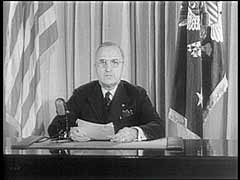
-
Jutta Szmirgeld
ArticleChildren's diaries bear witness to some of the most heartbreaking events of the Holocaust. Learn about the diary and experiences of Jutta Szmirgeld.
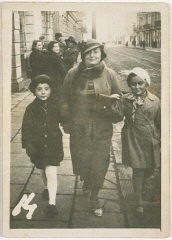
-
Anne Frank Biography: Who was Anne Frank?
ArticleAnne Frank is among the most well-known of the six million Jews who died in the Holocaust. Discover who Anne Frank was and what happened to her.
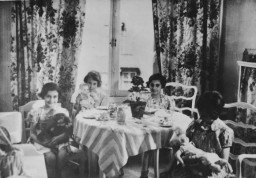
-
Death Marches
ArticleAs Allied forces approached Nazi camps in the last months of WWII, the SS organized brutal “death marches” (forced evacuations) of concentration camp inmates.

-
Tarnow
ArticleLearn about the prewar Jewish community of Tarnow, German occupation, deportations and killings of the Jewish population, ghettoization, and resistance.

-
Riga
ArticleGerman forces occupied Riga, Latvia in July 1941. Learn more about the establishment of the Riga ghetto, mass shootings of Jews, and Jewish resistance.

-
Life in the Ghettos
ArticleDuring the Holocaust, Jews were forced into ghettos with terrible living conditions, overcrowding, and starvation. Learn more about life in the Lodz ghetto.

-
The Biological State: Nazi Racial Hygiene, 1933–1939
ArticleBetween 1933-1939, Nazi eugenics and racial hygiene led to policies like mass sterilization and criminalizing marriage between Jews and non-Jews.

-
The Movement to Boycott the Berlin Olympics of 1936
ArticleSoon after Hitler came to power, debates began outside Germany about taking part in Olympics hosted by the Nazi regime. Learn more about calls to boycott the Games.
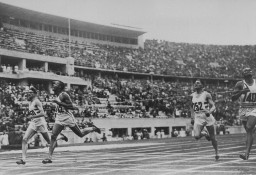
-
Althammer
ArticleThe Germans established the Althammer camp in September 1944. It was a subcamp of Auschwitz. Read more about the camp's history and conditions there.
-
King Christian X of Denmark
ArticleDid King Christian X of Denmark wear a yellow star in support of the Danish Jews? Read more about the historical truth behind the legend.
-
George Kadish
ArticleAt great risk, George Kadish secretly documented life in the Kovno ghetto in Lithuania, creating a key photographic record of ghetto life during the Holocaust.
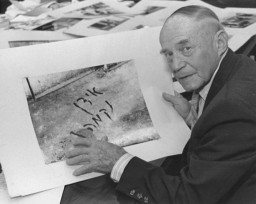
-
Soviet and US Troops Meet at Torgau
Timeline EventApril 25, 1945. On this date, Soviet and American troops met at Torgau, Germany.

-
Mass Shootings of Jews during the Holocaust
ArticleAlmost one third of the six million Holocaust victims were murdered in mass shootings.

-
Sandor (Shony) Alex Braun describes playing the violin for SS guards in Dachau. after two prisoners before him had been killed
Oral HistoryShony was born to religious Jewish parents in a small Transylvanian city. He began to learn the violin at age 5. His town was occupied by Hungary in 1940 and by Germany in 1944. In May 1944, he was deported to the Auschwitz camp in Poland. He was transferred to the Natzweiler camp system in France and then to Dachau, where he was liberated by US troops in April 1945. In 1950, he immigrated to the United States, and became a composer and a professional violinist.
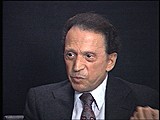
-
Abraham Bomba describes the Treblinka gas chambers
Oral HistoryExcerpt from Holocaust survivor Abraham Bomba's oral history testimony describing gas chambers at the Treblinka killing center.
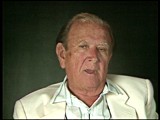
-
Uckermark Youth Camp
ArticleThe Uckermark camp was one of the so-called youth protection camps that the Nazi regime established for young people who were alleged to have strayed from Nazi norms and ideals.
-
Gerda Blachmann Wilchfort describes the mood of passengers on the "St. Louis" after they were denied entry into Cuba
Oral HistoryGerda and her parents obtained visas to sail to Cuba on the "St. Louis" in May 1939. When the ship arrived in Havana harbor, most of the refugees were denied entry and the ship had to return to Europe. Gerda and her parents disembarked in Belgium. In May 1940, Germany attacked Belgium. Gerda and her mother escaped to Switzerland. After the war, they were told that Gerda's father had died during deportation.

-
Kristallnacht
ArticleOn November 9–10, 1938, the Nazi regime coordinated a wave of antisemitic violence. This became known as Kristallnacht or the "Night of Broken Glass." Learn more

-
Rosa Israel Waldhorn
ID CardRosa was one of 14 children born to religious Jewish parents in the village of Yasinya at a time when it was known as Korosmezo and was part of Hungary. During World War I, she married Michael von Hoppen Waldhorn, an officer in the Austro-Hungarian army who was based near Yasinya. During the 1920s they moved to Paris, where they raised three children. 1933-39: The Waldhorn family's life in Paris was very different from their life in Hungary and Czechoslovakia. Rosa's husband made a good living, and he…
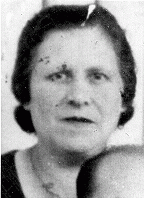
-
Robert Kulka
ID CardRobert was the son of Jewish parents, Leopold and Florentina Kulka, and was raised in the Moravian town of Olomouc. After completing secondary school, he attended a business school until 1909. He began a business in Olomouc and in 1933 he married Elsa Skutezka from the Moravian city of Brno. The couple made their home in Olomouc. 1933-39: The Kulkas' son, Tomas, was born a year and a day after they were married. In 1937 Elsa's father passed away and the Kulkas moved to Brno, where Elsa and her husband…
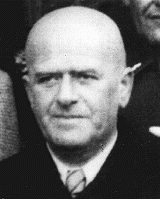
-
Tomas Kulka
ID CardTomas' parents were Jewish. His father, Robert Kulka, was a businessman from the Moravian town of Olomouc. His mother, Elsa Skutezka, was a milliner from Brno, the capital of Moravia. The couple was well-educated and spoke both Czech and German. They married in 1933 and settled in Robert's hometown of Olomouc. 1933-39: Tomas was born a year and a day after his parents were married. When Tomas was 3, his grandfather passed away and the Kulkas moved to Brno, which was his mother's hometown. On March 15,…

-
Ossi Stojka
ID CardOssi was the youngest of six children born to Roma ("Gypsies") who traveled in a family wagon. His family was Roman Catholic. Their caravan spent winters in Vienna, Austria's capital, and summers in the Austrian countryside. The Stojkas belonged to a tribe called the Lowara Roma, who made their living as itinerant horse traders. Ossi's ancestors had lived in Austria for more than 200 years. 1933-39: Ossi was 2 years old when Germany annexed Austria in March 1938. The Stojka family wagon was parked for the…

-
American propaganda announcement
DocumentAnnouncement dropped by American planes on Shanghai near the end of the war. [From the USHMM special exhibition Flight and Rescue.]
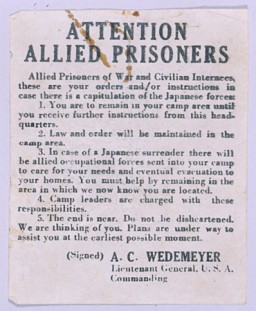
-
Gideon Boissevain
ID CardGideon was known affectionately as "Gi" by his family and friends. His parents were descended from the Huguenots, French Protestants who came to the Netherlands in the 16th and 17th centuries. Gi had two brothers and two sisters, and his father worked in the insurance business. 1933-39: Gi had a large circle of friends, both Christians and Jews, and after school they all liked to get together. He and his friends enjoyed taking bike trips, having parties, and playing records. In the mid-1930s his parents…
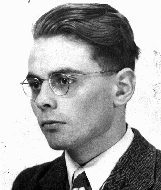
-
Dismissal letter
DocumentDuring the interwar period Dr. Susanne Engelmann served as the principal of a large public high school for girls in Berlin. This letter notified her of her dismissal, as a "non-Aryan," from her teaching position. The dismissal was in compliance with the Civil Service Law of April 7, 1933. On April 7, the German government issued the Law for the Restoration of the Professional Civil Service (Gesetz zur Wiederherstellung des Berufsbeamtentums), which excluded Jews and political opponents from all civil…
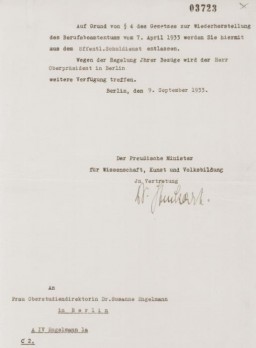
-
German military court trial of French resistance members
FilmFrance signed an armistice with Germany on June 22, 1940, recognizing the right of German authorities to oversee the French administration. Further, German military authorities held jurisdiction over matters of internal security. In this footage, a German military court in Paris tries French citizens charged with resisting measures of the military occupation. Despite harsh military justice, the Germans could not quell opposition in France, and resistance activities would reach a peak during the Allied…

